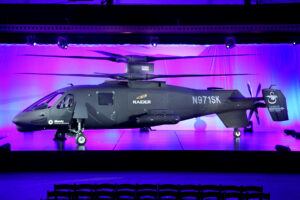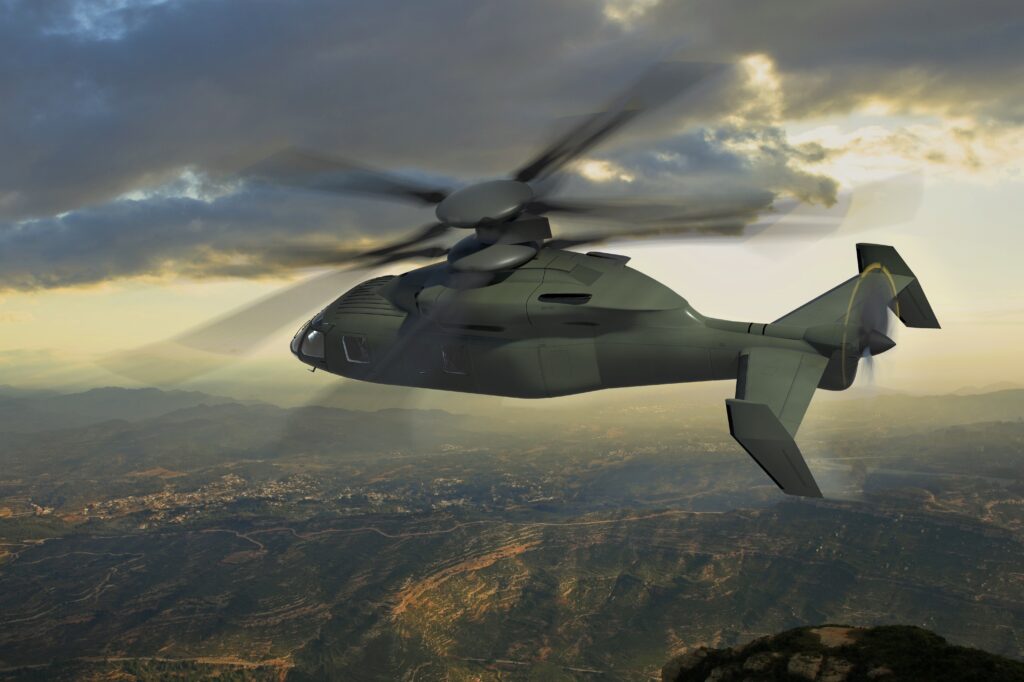Sikorsky Unveils S-97 Raider: Road To FVL?
Posted on
The company that built the first workable helicopter rolled out a (potential) revolution in chopper technology yesterday: Sikorsky’s high-speed S-97 Raider. A year ago, Sikorsky made a splash at the huge Association of the US Army conference with just a life-size mock-up. Now, just in time to talk it up at AUSA 2014, they’ve built a working prototype, which is supposed to start actually flying later this year.

The Sikorsky S-97 prototype.
In the meantime, though, the program the S-97 was built for has passed away. Under the budget pressures of sequestration, the Army has put the Armed Aerial Scout competition on indefinite hold. Instead, the service will replace its geriatric OH-58 Kiowa scout choppers with existing (and much heavier) AH-64 Apache gunships taken from the National Guard, a politically explosive decision.
So what’s the S-97 for? To some degree, it’s a proto-prototype for the SB>1 Defiant, currently being co-developed by Sikorsky and Boeing for the Joint Multi-Role (JMR) aircraft competition. JMR, in turn, is the first phase of an unnervingly ambitious Future Vertical Lift (FVL) initiative to replace a host of existing Army, Marine Corps, Navy, and Air Force helicopters with a family of high-tech, high-speed aircraft.
Sikorsky’s competition on this mega-program is the Bell V-280 Valor. It and the SB>1 are now both in the detailed design phase, headed for Critical Design Review by the Pentagon in 2015 and first flight no later than September 2017. For now, they’re flying in CGI:
The V-280 derives from the Bell-Boeing V-22 Osprey now in service with the Marines and Air Force Special Operations Command (AFSOC). The V-22 and V-280 are “tilt-rotor” designs: They achieve greater speed and range than conventional helicopters by having, in essence, giant propellers that can rotate into a helicopter-like position for vertical take-off and landing and into an airplane-like configuration for long-range flight.

A V-22 Osprey tilting its rotors
By contrast, the S-97 Raider and SB>1 Defiant designs derive from Sikorsky’s high-speed X-2. This approach looks much more like a conventional helicopter because it uses two rapidly counter-rotating rotors on a single axis — which doesn’t tilt — for high-speed flight.
Both teams claim their designs can top 250 miles per hour. Which approach will prove more appealing to the military? Rotors that tilt are mechanically complex (and according to some critics inherently unsafe), but they’re also in worldwide service with the Marines, including combat experience in Afghanistan, which make them a known quantity. “We’re picking up on lessons learned from V-22” for the V-280, Bell spokesman Andy Woodward told me. “We like to refer to it [V-280] as the third-generation tiltrotor,” tracing the technology back through the V-22 to the NASA XV-15 that first flew in 1977.
Counter-rotating dual rotors are arguably a more elegant approach, but they don’t have the same long track record: The X-2 first flew only six years ago. That means the burden of proof is on Sikorsky to show how well the technology works. That may well be the S-97’s biggest contribution.

The Sikorsky-Boeing SB>1 Defiant concept for the Joint Multi-Role demonstrator, a predecessor to the Future Vertical Lift aircraft.
Subscribe to our newsletter
Promotions, new products and sales. Directly to your inbox.
